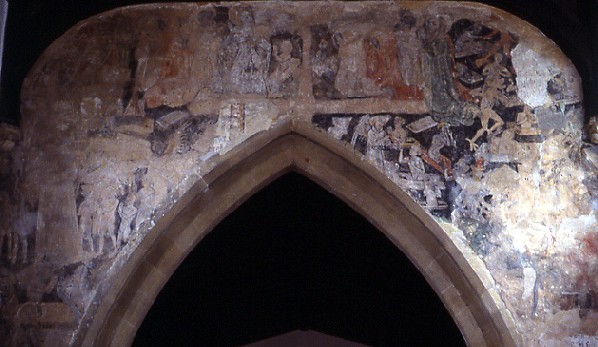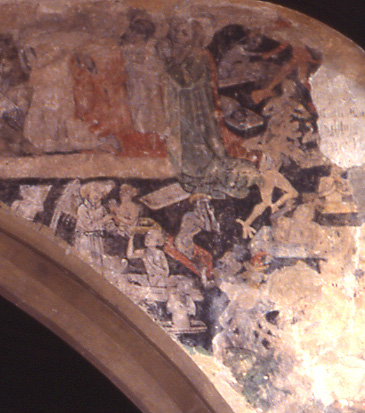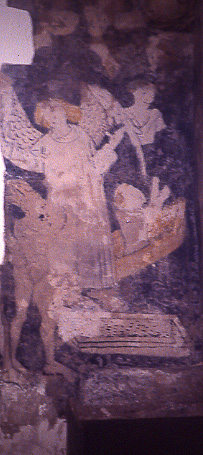Chesterton, Cambridgeshire (†Ely) C.14/15
Doom

A comparatively well-preserved and very detailed Doom, perhaps a little later in the fifteenth century than that at Broughton, also in Cambridgeshire. The outline of the Rood-beam and part of the upright of the Rood itself is visible in the centre, but the figure of the Judging Christ has gone, presumably when the roof was lowered sometime after the painting was made. The kneeling figures of the Virgin (left) and St John (right, wearing a green robe) are larger than any of the others; the Virgin may be holding out her arms to show souls sheltering inside her cloak, which is now devoid of colour and shows as white.

As is usually the case, the most interesting details here are on the side of the damned, in this case in the group of figures around and below St John (detail, right). At the top right, a red devil with large flat feet hauls one of the rising dead out of his grave, an unusual detail in itself, since although devils are never far away when the dead rise, such active assistance, or interference, from them before the moment of Judgement is rare. Directly below, another devil painted in very pale yellow ochre carries off another unfortunate on his shoulders, piggy-back style.

Directly below the right foot of this devil is another, incomplete and faint but wearing a hat with a brim and a domed red crown. The details are hard to see, but this devil appears to be pushing a wheelbarrow or handcart, as at Yaxley and Bacton, both in Suffolk. The headgear singles him out, and may mean that he is intended for Lucifer himself.
On the left-hand side of the chancel arch a large figure in a long robe is very obscure now, but he is probably St Peter, receiving the Saved. Several souls stand between him and the edge of the chancel arch, some possibly kneeling, and all in prayerful attitudes. In the detail at the right, an angel wearing white priestly vestments welcomes a bishop, naked except for his identifying mitre, and gestures towards the top centre of the scene. Other figures cluster around, and one in a reddish boat-shaped coffin raises his hands in wonder.
The Chesterton Doom is an interesting example of the subject, and it probably once had many more incidental details than are visible now. I suspect that the detail of the devil with the wheelbarrow was once quite common generally, and the Chesterton painting certainly confirms that it was not, at any rate, confined to Suffolk.
EW Tristram reported another faint subject, perhaps the Seven Works of Mercy, in a window splay in the south aisle, but I could find no trace of this. However, another painting described by Tristram, on a stone removed from the church and showing a haloed young woman holding a basket, is still in the Fitzwilliam Museum in Cambridge so far as I know.
Website of St Andrew’s, Chesterton (including some excellent close-up photographs of details from the Doom)